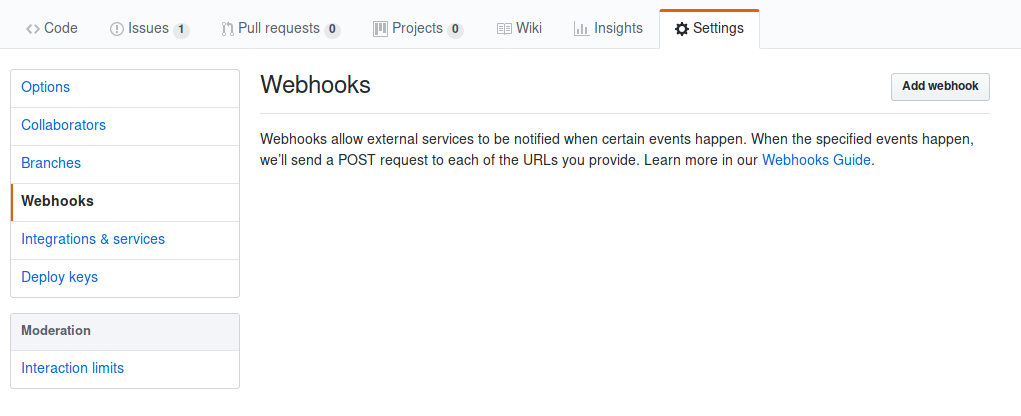How you deploy your projects? Are you using fancy things like Jenkins with lots of features and configuration that you don’t even know about? For one of my personal projects, I needed to have a deployment tools. I tried to install and configure Jenkins but there was no chance to make it up and running. So I decided to write my own, simple deployer with PHP.
Git Hooks
For this article we are using Git hooks. Git hooks are a script that Git runs before or after some events are triggered such as: commit, push, merge, creating a branch and so on. Although the equivalent of Git Hooks in web-based Git platforms such as Github, Gitlab or bitbucket are Webhooks, which instead of running a script, call a URL (usually in your server).
configure webhooks
first of all, we need to configure our repository to use webhooks. For this purpose, go to your repository settings and you will find Webhooks on the sidebar.

After clicking on Add webhook button you will see the webhook settings page:

Payload URL: the URL you want to send a POST request after or before an event
Content Type: specify how you want to receive data from GitHub
Secret: a secret key used for authorization
Which events would you like to trigger this webhook?:
- Just the push event: This option just send event name to the callback URL
- Send me everything: send everything to callback URL included repository and user information
- Let me select individual events: By choosing this option you are able to specify which events do you want to follow
For this article, we stick to the first option. You can play with other options when you get familiar with the whole process.
Deployer
In the previouse step we set the push event for our webhook. It means as soon as we push something to the repository, the following http request is sent to the payload url:
Request URL: http://mydomain.com/deployer.php
Request method: POST
content-type: application/x-www-form-urlencoded
Expect:
User-Agent: GitHub-Hookshot/233462e
X-GitHub-Delivery: ff42fb42-0107-11e9-961e-9dc5ae0da8b1
X-GitHub-Event: push
X-Hub-Signature: sha1=81407666112671798a83c608efa69d1052987fe9
As you can see, there are three custom headers which are set by Github. For authorization, we must use
X-Hub-Signature header. The value of X-Hub-Signature header is consists of a hash algorithm and a hash string.
Create a file called deployer.php and put the following content on it:
<?php
$secret = 'MYSECRETKEY';
if (!isset($_SERVER['HTTP_X_HUB_SIGNATURE'])) {
exit("Permision denied!");
}
Variable $secret is the secret key you had choosen in webhook settings. We need to compare value of HTTP_X_HUB_SIGNATURE header with sha1 value of POST request content. For this we used the following code:
$githubHeader = $_SERVER['HTTP_X_HUB_SIGNATURE'];
$rawPost = file_get_contents("php://input");
$secret = str_replace("sha1=", "", $githubHeader);
$hash = hash_hmac('sha1', $rawPost, $mySecret);
if ($hash != $secret){
exit ("Permission denied!");
}
First, we remove sha1= string from the header value then hash the post content to hash with the sha1 algorithm, then we compare the values.
$workTree = 'PROJECT_PATH';
$gitRoot = $workTree. '/.git';
$commands = array(
'pull',
'status',
'submodule sync',
'submodule update',
'submodule status',
);
$log = [];
$log[] = "####### ". date('Y-m-d H:i:s') ." #######";
foreach($commands as $cmd) {
$cmd = 'git --git-dir '.$gitRoot.' --work-tree '. $workDir . ' '. $cmd
$tmp = shell_exec("$cmd 2>&1");
$log[] = "\$ $cmd\n".trim($tmp)."\n";
}
$log = implode("\n", $log);
file_put_contents ('deployer.log', $log, FILE_APPEND);
exit('success');
$workTree value must point to our project directory. As soon as we push new changes to Git repository, GitHub sends a POST request to payload URL and above script will be run. After authentication, git pull and git status commands run and the output will be stored in deployer.log file.